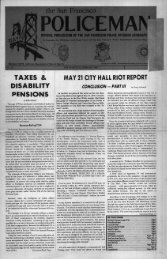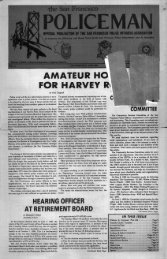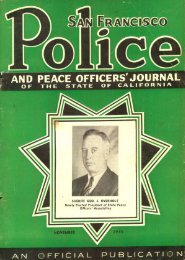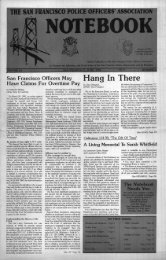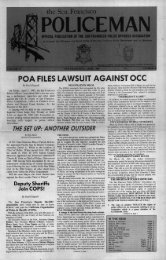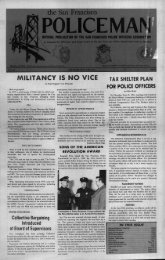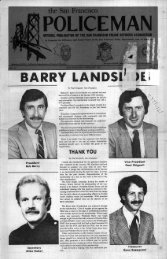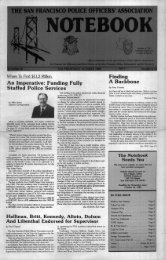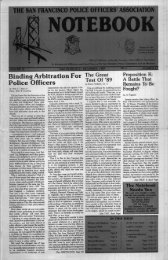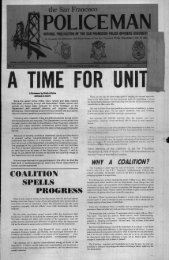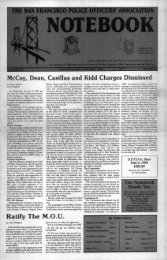October 1959 - San Francisco Police Officers Association
October 1959 - San Francisco Police Officers Association
October 1959 - San Francisco Police Officers Association
Create successful ePaper yourself
Turn your PDF publications into a flip-book with our unique Google optimized e-Paper software.
Vehicle code - continued<br />
quired to maintain the posted minimum<br />
speed.<br />
Sec. 21451 - - Pedestrians. New law<br />
requires pedestrians to wait on curbs of<br />
signal controlled intersections until all<br />
cars within the intersections have<br />
cleared.<br />
Sec. 21460—Highway Lanes. After<br />
September 28, <strong>1959</strong>, motorists may see<br />
solid yellow dividing lines in place of<br />
the old white ones. Under a new law<br />
either color is permissible. Laws regulating<br />
passing or driving to the left of<br />
these lines remain the same.<br />
"Raking" Now Limited<br />
Sec. 24008 - Custom Cars. New<br />
section prohibits operation of any passenger<br />
vehicle modified from its original<br />
design so that any portion of such<br />
vehicle has less clearance from the roadway<br />
surface than the lowest portion of<br />
the rim of any wheel in contact with<br />
the roadway. (In hot-rodder terminology,<br />
this lowering of a car is known as<br />
raking.")<br />
Sec. 12512 - Teen Age Drivers.<br />
Persons under sixteen (16) years of<br />
age, who have completed high school<br />
courses in driver training, will no<br />
longer qualify for a driver's license.<br />
The age limit for obtaining a driver's<br />
license has been revised to sixteen<br />
(16) for everyone, regardless of<br />
previous driver education or training.<br />
Sec. 23120—Eye Glasses. New section<br />
prohibits the operation of a motor<br />
vehicle by any person wearing glasses<br />
having a temple width of one-half (1/2)<br />
inch or more, if any part of such temple<br />
extends below the horizontal center<br />
of the lens so as to interfere with lateral<br />
vision.<br />
ALPHA STORES<br />
Complete Line of Groceries, Meats and<br />
Vegetables - Liquor<br />
960 COLE STREET<br />
LOmbard 4-8910<br />
FULTON FOOD SHOP<br />
Groceries - Delicatessen<br />
Wines and Liquors<br />
1801 FULTON STREET<br />
EVergreen 6-9790 <strong>San</strong> <strong>Francisco</strong>, Calif<br />
Re-Elect . . DR. CHARLES A.<br />
ERTOLA<br />
SUPERVISOR<br />
INCUMBENT<br />
(Paid Pol. Ad)<br />
By DICK PATTEN<br />
Your closest friend in the radio car<br />
is Mike. Look at him, he can save your<br />
life. This thought should make you<br />
give as much regard to this instrument<br />
as you would your own life or the life<br />
of your closest buddy.<br />
You have seen the microphone almost<br />
every day of your life, but have you<br />
had a formal introduction? If you have,<br />
let me renew your acquaintance. If not,<br />
let me introduce you.<br />
Mike and Little Mike<br />
There are two microphones in most<br />
radio cars. For the sake of introduction,<br />
let me refer to them as Mike and<br />
his brother, Little Mike. Mike, the most<br />
frequently used, is the one on the left<br />
and Little Mike is the one on the right.<br />
Mike and his brother have between<br />
them a control panel which has a power<br />
switch, volume knob, P.A. switch,<br />
channel switch and two indicator lights.<br />
Important Uses<br />
Mike is used for all radio transmissions<br />
while Little Mike is used for the<br />
Loudspeaker P.A. System. In order to<br />
use Mike correctly, the transmitter<br />
switch must be depressed, but care must<br />
be used in the depression and releasing<br />
of this switch as it has been known to<br />
stick in the depressed position, thereby<br />
making every word uttered in the radio<br />
car a matter of common knowledge. As<br />
well as being embarrassing to the parties<br />
involved, this also clutters the air and<br />
makes transmission by other cars impossible.<br />
The Power Switch:<br />
The power switch is the toggle switch<br />
on the left side of the control panel<br />
and is used to put power into the set.<br />
When the switch is in the up position,<br />
the set is on.<br />
The Squelch Knob:<br />
The squelch is used in order to clear<br />
interference and should be operated in<br />
the following manner. Turn the knob<br />
all the way to the right, wait for static,<br />
when the static comes through loud<br />
and clear, turn the knob to the left only<br />
as far as is necessary to cut out the<br />
Elect<br />
TOM GOSLAND<br />
Your Supervisor<br />
- Will Devote Full Time to Job -<br />
(Paid political ado.)<br />
How Mike and Little<br />
tatic. Do not turn the knob all the way<br />
to the left as your best reception is had<br />
by just turning the knob until the<br />
static clears. If the knob is turned all<br />
the way to the left the receiver sensitively<br />
is cut down.<br />
Channel Selector Switch:<br />
The radio car is equipped with two<br />
channels, i.e.<br />
Channel 1—the switch is placed in<br />
the up position. This is the regular<br />
channel and is used for all regular police<br />
patrol car transmissions.<br />
Channel 2: The switch is placed in<br />
the down position. This is the emergency<br />
channel. Channel 2 should only<br />
be used in the necessity of immediate<br />
response by headquarters or in the<br />
event that headquarters should direct<br />
you to switch to this channel.<br />
The P.A. Switch<br />
The normal position for this switch<br />
is in the center. To broadcast over the<br />
P.A. the switch is placed in the up<br />
position. You will receive normal transmissions<br />
and will be able to broadcast<br />
by using Little Mike, the one on the<br />
right.<br />
Benefit basketball<br />
game set for PAL<br />
On Friday, November 20, the newest<br />
entry into the National Industrial<br />
League, the A. J. Lefferdink "Investors"<br />
will play their first game for the<br />
benefit of the <strong>Police</strong> Athletic League.<br />
Phe game will be played against the<br />
Kirby Shoe Company of Los Angeles<br />
at the USF gym. The Investors are<br />
coached by Jim Walsh, a <strong>San</strong> <strong>Francisco</strong><br />
standout, who starred for Stanford and<br />
later the Phillips Oilers. Jim Walsh's<br />
brother, Tom, is a policeman assigned<br />
to the Accident Bureau.<br />
These teams are made up of former<br />
college stars. Both teams play a brand<br />
of ball that has become more and more<br />
popular all over the country. The tickets<br />
will be $1.50 on a general admission<br />
basis. They will be on sale at Roos-Atkins<br />
and most of the regular box offices<br />
as well as available through the P.A.L.<br />
There will be no general ticket sale<br />
as there is with the ball tickets but it is<br />
hoped that the nature of the benefit<br />
will put all policemen behind the affair<br />
and make it the success that it deserves<br />
to be.<br />
SAN FRANCISCO POLICE



